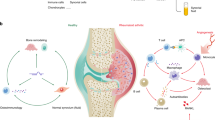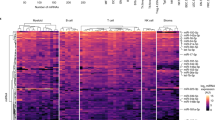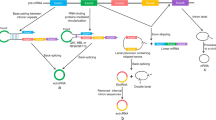Abstract
MicroRNAs (miRNAs) are short noncoding RNA molecules that modulate the expression of multiple target genes at the post-transcriptional level and are implicated in a wide array of cellular and developmental processes. In hematopoietic cells, miRNA levels are dynamically regulated during lineage differentiation and also during the course of the immune response. Mouse models have provided good evidence for miRNAs being key players in the establishment of hematopoietic lineages. Furthermore, miRNA-dependent alterations in gene expression in hematopoietic cells are critical for mounting an appropriate immune response to a wide range of pathogens, spontaneously emerging tumors, and autoimmune cells. Deregulation of hematopoietic-specific miRNA expression results in defects in both central and peripheral tolerance, hematopoietic malignancies, and sometimes both. Abnormal expression of miRNAs—which is implicated in inflammation—has also been found in patients with rheumatoid arthritis. These findings identify miRNAs as critical targets for immunomodulatory drug development.
Key Points
-
microRNAs (miRNAs) are small noncoding RNAs that control the expression of a number of genes by post-transcriptionally modulating the expression of key targets
-
miRNAs usually block protein translation or induce degradation of their target mRNAs; however, enhancement of translation of repressed transcripts has also been reported
-
miRNAs display a tissue-specific pattern of expression, and their levels are dynamic during lineage differentiation of hematopoietic cells
-
Mouse models developed so far provide evidence that miRNAs are not only differentially expressed in hematopoietic lineages, but also that they have a physiological role during differentiation processes
-
Altered expression of some miRNAs is found in patients with rheumatoid arthritis
-
miRNAs are promising targets for immunomodulatory drugs
This is a preview of subscription content, access via your institution
Access options
Subscribe to this journal
Receive 12 print issues and online access
$209.00 per year
only $17.42 per issue
Buy this article
- Purchase on Springer Link
- Instant access to full article PDF
Prices may be subject to local taxes which are calculated during checkout


Similar content being viewed by others
References
Lee RC et al. (1993) The C. elegans heterochronic gene lin-4 encodes small RNAs with antisense complimentary to lin-14. Cell 75: 843–854
Ambros V (2004) The functions of animal microRNAs. Nature 431: 350–355
Lagos-Quintana M et al. (2001) Identification of novel genes coding for small expressed RNAs. Science 294: 853–858
Ambros V (2003) MicroRNA pathways in flies and worms: growth, death, fat, stress, and timing. Cell 113: 673–676
Bartel DP (2004) MicroRNAs: genomics, biogenesis, mechanism, and function. Cell 116: 281–297
Calin GA et al. (2002) Frequent deletions and down-regulation of micro-RNA genes miR15 and miR16 at 13q14 in chronic lymphocytic leukemia. Proc Natl Acad Sci USA 99: 15524–15529
Tili E et al. (2007) miRNAs and their potential for use against cancer and other diseases. Future Oncol 5: 521–537
Calin GA and Croce CM (2006) MicroRNA signatures in human cancers. Nat Rev Cancer 6: 857–866
Gaur A et al. (2007) Characterization of microRNA expression levels and their biological correlates in human cancer cell lines. Cancer Res 67: 2456–2468
Chen CZ et al. (2004) MicroRNAs modulate hematopoietic lineage differentiation. Science 303: 83–86
Monticelli S et al. (2005) MicroRNA profiling of the murine hematopoietic system. Genome Biol 6: R71
Georgantas RW 3rd et al. (2007) CD34+ hematopoietic stem-progenitor cell microRNA expression and function: a circuit diagram of differentiation control. Proc Natl Acad Sci USA 104: 2750–2755
Neilson JR et al. (2007) Dynamic regulation of miRNA expression in ordered stages of cellular development. Genes Dev 21: 578–589
Tili E et al. (2007) Modulation of miR-155 and miR-125b levels following lipopolysaccharide/TNF-alpha stimulation and their possible roles in regulating the response to endotoxin shock. J Immunol 179: 5082–5089
Taganov KD et al. (2006) NF-kappaB-dependent induction of microRNA miR-146, an inhibitor targeted to signaling proteins of innate immune responses. Proc Natl Acad Sci USA 103: 12481–12486
Zhou B et al. (2007) miR-150, a microRNA expressed in mature B and T cells, blocks early B cell development when expressed prematurely. Proc Natl Acad Sci USA 104: 7080–7085
Wu H et al. (2007) miRNA profiling of naïve, effector and memory CD8 T cells. PLoS ONE 2: e1020
Michael MZ et al. (2003) Reduced accumulation of specific microRNAs in colorectal neoplasia. Mol Cancer Res 1: 882–891
Pedersen IM et al. (2007) Interferon modulation of cellular microRNAs as an antiviral mechanism. Nature 18: 919–922
Cullen BR (2004) Transcription and processing of human microRNA precursors. Mol Cell 16: 861–865
Raabe T et al. (1998) Relative contribution of transcription and translation to the induction of tumor necrosis factor-alpha by lipopolysaccharide. J Biol Chem 273: 974–980
Vasudevan S et al. (2007) Switching from repression to activation: microRNAs can up-regulate translation. Science 318: 1931–1934
Place FR et al. (2008) MicroRNA-373 induces expression of genes with complementary promoter sequences. Proc Natl Acad Sci USA 105: 1608–1613
Ventura A et al. (2008) Targeted deletion reveals essential and overlapping functions of the miR-17 through 92 family of miRNA clusters. Cell 132: 875–886
He L et al. (2005) microRNA polycistron as a potential human oncogene. Nature 435: 828–833
Xiao C et al. (2008) Lymphoproliferative disease and autoimmunity in mice with increased miR-17-92 expression in lymphocytes. Nat Immunol 9: 405–414
Xiao C et al. (2007) MiR-150 controls B cell differentiation by targeting the transcription factor c-Myb. Cell 131: 146–159
Eis PS et al. (2005) Accumulation of miR-155 and BIC RNA in human B cell lymphomas. Proc Natl Acad Sci USA 102: 3627–3632
Tam W et al. (1997) Bic, a novel gene activated by proviral insertions in avian leukosis virus-induced lymphomas, is likely to function through its noncoding RNA. Mol Cell Biol 17: 1490–1502
Costinean S et al. (2006) Pre-B cell proliferation and lymphoblastic leukemia/high-grade lymphoma in E(mu)-miR155 transgenic mice. Proc Natl Acad Sci USA 103: 7024–7029
Thai TH et al. (2007) Regulation of the germinal center response by microRNA-155. Science 316: 604–608
Rodriguez A et al. (2007) Requirement of bic/microRNA-155 for normal immune function. Science 316: 608–611
Vigorito E et al. (2007) microRNA-155 regulates the generation of immunoglobulin class-switched plasma cells. Immunity 27: 847–859
Skalsky RL et al. (2007) Kaposi's sarcoma-associated herpesvirus encodes an ortholog of miR-155. J Virol 81: 12836–12845
Gironella M et al. (2007) Tumor protein 53-induced nuclear protein 1 expression is repressed by miR-155, and its restoration inhibits pancreatic tumor development. Proc Natl Acad Sci USA 104: 16170–16175
Li QJ et al. (2007) miR-181a is an intrinsic modulator of T cell sensitivity and selection. Cell 129: 147–161
Kaushansky K (2006) Lineage-specific hematopoietic growth factors. N Engl J Med 354: 2034–2045
Davidson WF et al. (1979) Phenotypic and functional effects of the motheaten gene on murine B and T lymphocytes. J Immunol 122: 884–891
Fazi F et al. (2007) Epigenetic silencing of the myelopoiesis regulator microRNA-223 by the AML1/ETO oncoprotein. Cancer Cell 12: 457–466
Johnnidis JB et al. (2008) Regulation of progenitor cell proliferation and granulocyte function by microRNA-223. Nature 451: 1125–1129
Nakasa T et al. (2008) Expression of microRNA-146 in rheumatoid arthritis synovial tissue. Arthritis Rheum 58: 1284–1292
Stanczyk J et al. (2008) Altered expression of MicroRNA in synovial fibroblasts and synovial tissue in rheumatoid arthritis. Arthritis Rheum 58: 1001–1009
Targetscan [http://www.targetscan.org]
Jacob CO et al. (1996) Mutational analysis of TNF-alpha gene reveals a regulatory role for the 3′-untranslated region in the genetic predisposition to lupus-like autoimmune disease. J Immunol 156: 3043–3050
Calin GA et al. (2005) A MicroRNA signature associated with prognosis and progression in chronic lymphocytic leukemia. N. Engl J Med 353: 1793–1801
Jakymiw A et al. (2006) Autoimmune targeting of key components of RNA interference. Arthritis Res Ther 8: R87
Yu D et al. (2007) Roquin represses autoimmunity by limiting inducible T-cell co-stimulator messenger RNA. Nature 450: 299–303
Leirisalo-Repo M (2005) Early arthritis and infection. Curr Opin Rheumatol 17: 433–439
Callan MF (2004) Epstein–Barr virus, arthritis, and the development of lymphoma in arthritis patients. Curr Opin Rheumatol 6: 399–405
Stern-Ginossar N et al. (2007) Host immune system gene targeting by a viral miRNA. Science 317: 376–381
Gottwein E et al. (2007) A viral microRNA functions as an orthologue of cellular miR-155. Nature 450: 1096–1099
Ramkissoon SH et al. (2006) Hematopoietic-specific microRNA expression in human cells. Leuk Res 30: 643–647
Elmén J et al. (2008) LNA-mediated microRNA silencing in non-human primates. Nature 452: 896–899
Chen XM et al. (2007) A cellular micro-RNA, let-7i, regulates Toll-like receptor 4 expression and contributes to cholangiocyte immune responses against Cryptosporidium parvum infection. J Biol Chem 282: 28929–28938
O'Donnell KA et al. (2005) c-Myc-regulated microRNAs modulate E2F1 expression. Nature 435: 839–843
Hariharan M et al. (2005) Targets for human encoded microRNAs in HIV genes. Biochem Biophys Res Commun 337: 1214–1218
Dore LC et al. (2008) A GATA-1-regulated microRNA locus essential for erythropoiesis. Proc Natl Acad Sci USA 105: 3333–3338
Yin Q et al. (2008) B-cell receptor activation induces BIC/miR-155 expression through a conserved AP-1 element. J Biol Chem 283: 2654–2662
Naguibneva I et al. (2006) The microRNA miR-181 targets the homeobox protein Hox-A11 during mammalian myoblast differentiation. Nat Cell Biol 8: 278–284
Author information
Authors and Affiliations
Corresponding author
Ethics declarations
Competing interests
The authors declare no competing financial interests.
Rights and permissions
About this article
Cite this article
Tili, E., Michaille, JJ., Costinean, S. et al. MicroRNAs, the immune system and rheumatic disease. Nat Rev Rheumatol 4, 534–541 (2008). https://doi.org/10.1038/ncprheum0885
Received:
Accepted:
Published:
Issue Date:
DOI: https://doi.org/10.1038/ncprheum0885
This article is cited by
-
Exercise mimetics: a novel strategy to combat neuroinflammation and Alzheimer’s disease
Journal of Neuroinflammation (2024)
-
In silico genome-wide miRNA-QTL-SNPs analyses identify a functional SNP associated with mastitis in Holsteins
BMC Genetics (2019)
-
Synchronized Orchestration of miR-99b and let-7g Positively Regulates Rotavirus Infection by Modulating Autophagy
Scientific Reports (2019)
-
Primary Sjögren’s syndrome: clinical phenotypes, outcome and the development of biomarkers
Immunologic Research (2017)
-
The prognostic effect of PTEN expression status in colorectal cancer development and evaluation of factors affecting it: miR-21 and promoter methylation
Journal of Biomedical Science (2016)



